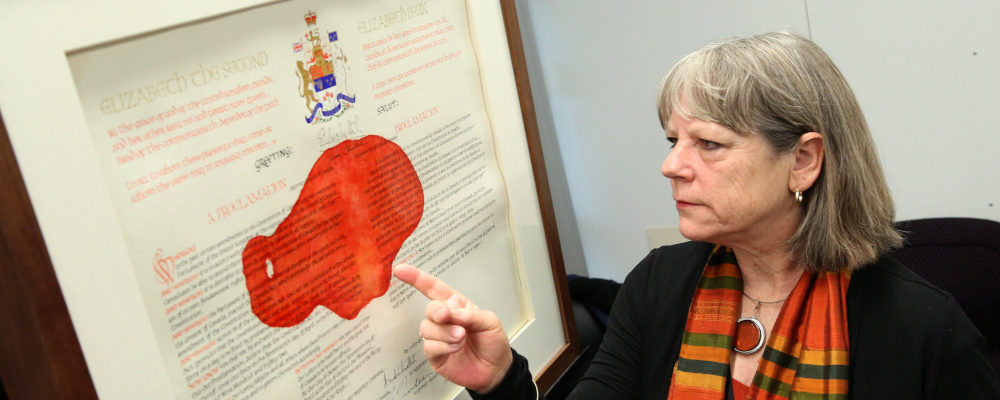Earlier this year, to mark the 40th anniversary of the patriation of the Canadian Constitution, UBC law professor Brian Bird wrote a four-part series1 for The Hub tracing Canada’s constitutional history from Confederation to the present, ending with some thoughts about our constitutional future. It is an erudite and accessible journey through more than a century and a half of legal history, which I recommend to anyone interested in understanding the significance of 1982 as an inflection point in the modern history of Canada. In my own rather more polemical series, I make the case that by 1982 Pierre Trudeau’s constitutional vision, which was grounded in the Enlightenment values of liberal rationalism, was already outdated and that Canada’s new Constitution has thrived not on Trudeau’s intended terms, but as a broadly illiberal exercise of irrational judicial power. Here is the final installment in the series. Click here for parts one, two, and three.
Defenders of the Canadian Constitution believe that its liberal principles are the best—and probably the only—way to accommodate differences of political opinion in a post-modern society1 Or, perhaps, “liquid modern” society. and to reconcile the interests of minorities and majorities. For this to work, they say, we need the courts constantly tugging and prodding governments to adhere to these liberal principles, even if that means limiting the scope of political choice in the democratic process and removing some controversies from the political sphere altogether.2In practice, those controversies that the polity stubbornly refuses to resolve once and for all along the lines preferred by liberal philosophy or neoliberal interests. Their argument assumes, of course, that the process of judicial review that we currently have is itself rational. It is not.
In Canada, courts reviewing legislation apply what is called the principle of proportionality, which it first announced and framed in the 1986 case of R. v. Oakes.3See parts two and three of this series for more discussion and background. Briefly stated, proportionality requires that a law furthering an important social goal must not limit a protected right more than is necessary to achieve that goal. To do this, the court applies a three-part balancing test.4The test is variously described as having three or four parts. A standard statement of it can be found here.
First, the law must be rationally connected to the important and necessary (“pressing and substantial”) objective the government wants to achieve. Second, the law must be likely to achieve its objective in a way that minimally limits protected rights. Finally, the law must be proportionate stricto senso (“in a strict sense”). That is, the government must strike the right balance between limiting protected rights and furthering social goods.
This all sounds good in theory; the problem is that, in reality, it’s a little more complicated. Those of you who escaped indoctrination into the cult of proportionality at law school may have noticed a niggling flaw in the method described above: the metrics are essentially arbitrary. The relative weights of benefit and harm are not fixed by a common and objective standard. The judge has no yardstick by which to measure the limitation of an individual right (on the one hand) and the diffuse benefits of the law to the common good (on the other). This is called the incommensurability problem, or the impossibility of comparing fundamentally different goods.
The incommensurability problem has been illustrated by the challenge of being asked to choose the fastest car at the lowest price: which car you choose will depend on how much value you choose to assign to speed and how much to price. Those choices are, if not exactly arbitrary, invariably subjective. There is not only no right or wrong answer, one can’t even say that there are better or worse answers.
This makes the incommensurability problem a different challenge entirely than the proverbially difficult comparison of apples and oranges; compared with the hardest questions of law and public policy, apples and oranges are actually comparable along many lines (size, price, colour, ripeness). Courts will sometimes attempt to turn the incommensurability problem into a relatively more soluble “apples and oranges” problem by describing both individual rights and public goods using a neutral term, just as price can be used to compare different fruits.
For example, a court may refer to both rights and goods as “interests” and then weigh the competing “interests” against another. But this doesn’t solve the problem; it avoids it.5Using price to compare apples and oranges may also avoid the problem of comparison if price is not a contextually relevant measure, but it is at least an objective standard. This kind of proportionality analysis “succeeds” only by distorting the nature of both individual rights and the common good. Calling rights mere personal “interests” neuters their moral force, and reducing the public good to a social “interest” misunderstands the purpose of government. In any event, the distortions are in vain. A judge can still only pretend to balance these illusory interests on an imaginary scale.
Even if one could establish a common metric for both individual rights and public goods, how would you start to assign weights to each side of the equation so that they could be usefully compared? Each judge must do this according to his or her personal judgement. Although most judges do this in good faith and with the best of intentions, the inherent subjectivity of the exercise explains why panels of judges so often disagree in Charter cases, despite working from the same facts and law. Proportionality, in practice, provides only illusory escape from the hard business of governing. Constitutional balancing tests “solve” the incommensurability problem in hard cases by producing judgements that are, as legal scholar Richard Ekins has written, “underdetermined by reason.”6 R Ekins, “Legislating Proportionally” in G Huscroft, B Miller and G Webber, Proportionality and the Rule of Law (CUP 2014).
As a rough and ready heuristic for political decision-making, the idea of proportionality is helpful, but it can’t escape the fact that governing requires us to make decisions involving incommensurable interests, immeasurable effects, and unknowable outcomes. The degree to which these things are incommensurable, immeasurable, and unknowable in a specific case will vary, but only in the easiest of cases will there be clear answers that most reasonable people can agree on—and we do not need courts for easy cases.
For the hard cases, a society needs a decision-making process intimately attuned to its unique pre-political religious and moral intuitions, stories and legends, social structures, geographic pressures, and economic organisation. One can imagine different forms of government that could do this; none would look like a courtroom under the formal constraints of modern litigation.
We had such a system of government before 1982, and we could have had a modified but still recognizable version after 1982 if the courts had chosen a path of self-restraint. When this alternative is put to Canadian judges, however, the most common response is a shrug and a half-hearted protest that amounts to: “We didn’t choose the powers the new constitution gave, and we can’t simply choose not to exercise them.”7Three examples among many will suffice. “Beverley McLachlin on her controversies, activism, Supreme Court legacy” (CBC interview with Rosemary Barton, Dec 17, 2017) (“But the fact is [the Charter] became the law of the land. It became the Constitution, and the judiciary had no choice but to uphold that law.”); Rt Hon Beverley McLachlin, “Respecting Democratic Roles” (Speech, Nov 22, 2004) (“Where a legal issue is properly before a court, not deciding is not an option.”); Vriend v. Alberta, 1998 (“[I]t should be emphasized again that our Charter’s introduction and the consequential remedial role of the courts were choices of the Canadian people through their elected representatives as part of a redefinition of our democracy. … So courts in their trustee or arbiter role must perforce scrutinize the work of the legislature and executive not in the name of the courts, but in the interests of the new social contract that was democratically chosen. All of this is implied in the power given to the courts under s. 24 of the Charter and s. 52 of the Constitution Act, 1982.”) Hand-waving at “all of this”—by which Justice Iacobucci includes many specific and not at all obvious jurisprudential choices and precedents—and blaming the democratic bodies that empowered the courts rather than the choices the courts made in exercising that power, hardly qualifies as a justification. It is the intellectual equivalent of a policeman clubbing an innocent bystander shrugging and saying “well, I was empowered to enforce the law.” But they did and they still could.
The adoption of the Oakes test and proportionality review was not pre-ordained; it was a choice. So was the decision to reject the more obvious procedural meaning of “principles of fundamental justice” in favour of interpreting it as a new judicial authority to impose new substantive limits on parliament’s legislative power. And so were the cramped reading of Section 1’s “reasonable limits” that clipped parliament’s wings and, later, the expansion of the already-stretched limits of Charter rights to include an obscure penumbra of “Charter values.” Each of these was a choice that took us further from the old Constitution but also, ironically, further from Trudeau’s vision.
Sometime between 1789 and 1968, the children of the Enlightenment lost their faith. As with Woolf’s diagnosis of Modernism in 1910, the change “was not sudden and definite,” but in hindsight, we can see that by 1982 that our society was badly fractured. The Enlightenment belief in progress and trust in science to guide (rather than serve) society had mostly evaporated. The corrosive logic of liberalism had dissolved the ancient bonds of family, culture, and religion, leaving a residue of confusion waiting for a new order to be born.
That was the moment Pierre Trudeau chose to enact his rationalist Constitution. It was a bold gambit, and a naïve one. To the extent it has succeeded it has done so, ironically, through an irrational exercise of judicial power that he should have predicted but almost certainly did not intend. Nevertheless, Trudeau’s constitutional legacy remains broadly popular. This is partly because it is ferociously defended by the powerful interests it serves, but mostly because, until we better understand our still-inchoate post-rational, post-liberal present, it feels safer than the alternative. For most of us, an anachronistic vision is better than no vision.




